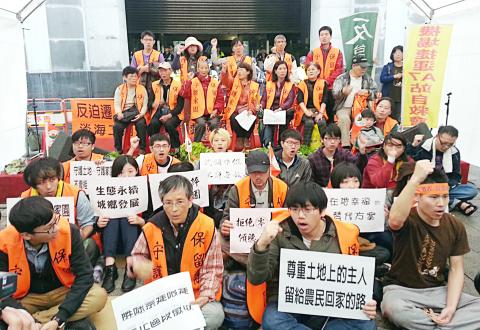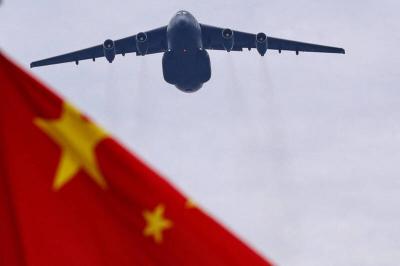Opponents of the phase-II development of Tamhai New Town (淡海新市鎮) yesterday asked the central government to evaluate the deal’s social and economic impact on the community and to hold a public hearing before setting the boundaries for the land seizure.
As the Environmental Protection Administration (EPA) was scheduled to hold its fourth meeting on setting the boundaries of the development yesterday, dozens of residents of New Taipei City’s Tamsui District (淡水), environmental activists and Tamkang University students camped outside EPA headquarters beginning on Wednesday night, to appeal to the public on the issue.
They protested before the meeting started yesterday morning and demanded that members of the review board go over the details of the development deal line-by-line.

Photo: CNA
Lu Cheng-chung (盧正忠), who is with a group opposing the town’s further development, said they thought the EPA was helping the Ministry of Interior’s Construction and Planning Agency rush through the boundary-setting meetings to get them done in one day.
Lu said the proposed phase-II development would force more than 1,600 households to relocate. He added that the new development is unnecessary because there are still many unsold houses and underdeveloped properties within the boundaries of the phase-I development.
“The Construction and Planning Agency said that the land expropriated for the phase-II development would be used to build an eco-friendly city and a ‘paradise for elderly citizens,’ but we feel that our environment is already rich in terms of biodiversity,” Lu said. “It is really gratuitous to destroy the biodiversity and build an artificial eco-friendly city. The elderly people in the community are, on the other hand, happy and self-sufficient. They do not need to be relocated so that a ‘paradise’ can be built for them.”
Lu said the government has planned to seize about 1,200 hectares of land for the phase-II development, with most of the targeted area being farmland.
Ling Hong Ching-tze (林洪清子), who is in her 80s, said this was not the first time that the government has seized her property. She said that she was once asked to give up 661 hectares for a section of highway to be built, and was compensated with just NT$1.7 million (US$56,000 at current exchange rates).
She added that she has been approached again by developers because of the project.
She said she was told that she would have to swap a larger area of land for a smaller one and buy back the land that she owned.
“I am pretty content with the land I have now, which has natural water coming from Datunshan (大屯山),” she said. “How can I find the money to buy back the land? And I should not have to buy back land that is mine.”
Residents supporting the development responded with their own data, saying that 542 households would need to relocate.
Tamsui District Administrator Tsai Yeh-wei (蔡葉偉) said that about 157 hectares of land to be expropriated are fallow farmland, with no trees, endangered species or historical sites to be protected.
One woman held a poster bearing the signatures of other residents who support the proposed development. She said development is good for the community, since more than 70 percent of its young people have left town to seek jobs elsewhere.

Beijing could eventually see a full amphibious invasion of Taiwan as the only "prudent" way to bring about unification, the US Department of Defense said in a newly released annual report to Congress. The Pentagon's "Annual Report to Congress: Military and Security Developments Involving the People's Republic of China 2025," was in many ways similar to last year’s report but reorganized the analysis of the options China has to take over Taiwan. Generally, according to the report, Chinese leaders view the People's Liberation Army's (PLA) capabilities for a Taiwan campaign as improving, but they remain uncertain about its readiness to successfully seize

HORROR STORIES: One victim recounted not realizing they had been stabbed and seeing people bleeding, while another recalled breaking down in tears after fleeing A man on Friday died after he tried to fight the knife-wielding suspect who went on a stabbing spree near two of Taipei’s busiest metro stations, Taipei Mayor Chiang Wan-an (蔣萬安) said. The 57-year-old man, identified by his family name, Yu (余), encountered the suspect at Exit M7 of Taipei Main Station and immediately tried to stop him, but was fatally wounded and later died, Chiang said, calling the incident “heartbreaking.” Yu’s family would receive at least NT$5 million (US$158,584) in compensation through the Taipei Rapid Transit Corp’s (TRTC) insurance coverage, he said after convening an emergency security response meeting yesterday morning. National

Taiwan has overtaken South Korea this year in per capita income for the first time in 23 years, IMF data showed. Per capita income is a nation’s GDP divided by the total population, used to compare average wealth levels across countries. Taiwan also beat Japan this year on per capita income, after surpassing it for the first time last year, US magazine Newsweek reported yesterday. Across Asia, Taiwan ranked fourth for per capita income at US$37,827 this year due to sustained economic growth, the report said. In the top three spots were Singapore, Macau and Hong Kong, it said. South

PLANNED: The suspect visited the crime scene before the killings, seeking information on how to access the roof, and had extensively researched a 2014 stabbing incident The suspect in a stabbing attack that killed three people and injured 11 in Taipei on Friday had planned the assault and set fires at other locations earlier in the day, law enforcement officials said yesterday. National Police Agency (NPA) Director-General Chang Jung-hsin (張榮興) said the suspect, a 27-year-old man named Chang Wen (張文), began the attacks at 3:40pm, first setting off smoke bombs on a road, damaging cars and motorbikes. Earlier, Chang Wen set fire to a rental room where he was staying on Gongyuan Road in Zhongzheng District (中正), Chang Jung-hsin said. The suspect later threw smoke grenades near two exits